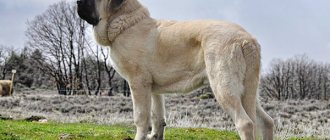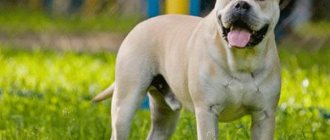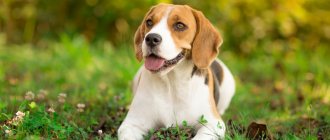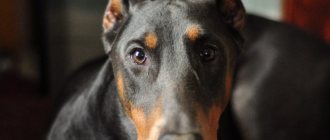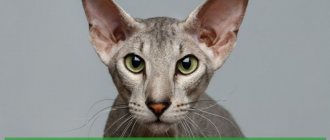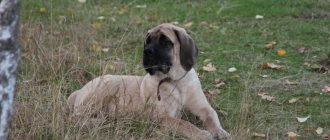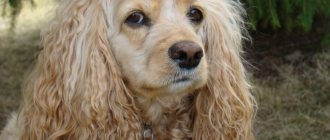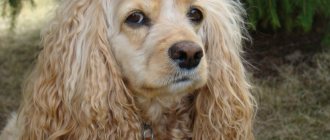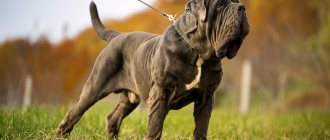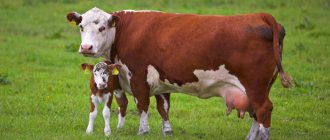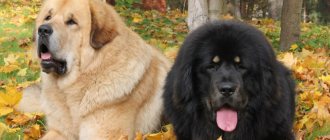There is currently no consensus on where mastiffs originated. A probable theory is that the ancestors of the modern breed were Molossians from Central Asia. The ancient mastiffs of the world were fighting dogs. They took part in baiting wild animals: bears, wild boars, lions. Mastiffs were often used as weapons, because the dog could easily cope with several armed soldiers in a short period of time. Over time, not a trace remained of the animal’s aggression and cruelty. Now he is a completely good-natured and devoted dog, able to understand his owner and make friends with others, including other animals.
brief information
The International Canine Federation officially recognizes 10 types of mastiffs, while there are more than 20 of them in the world. Aboriginal breeds are few in number and cannot boast of a solid history or purity of blood.
Despite some differences in appearance, mastiffs are united by the standard of the breed group:
- Tall height - from 65 cm at the withers, large body weight.
- The head is volumetric-angular, massive in appearance.
- Strong, wide bones, powerful muscles.
- Tucked belly.
- A noticeable supply of “extra” skin, gathered into cozy folds, especially on the head, chest, and neck.
- Pronounced jowls on square jaws.
Small, widely spaced brown eyes, which have known all the wisdom of the world, complement the portrait of a typical mastiff.
Purpose of the breed and maintenance features:
- Life expectancy is 9-14 years .
- Use: friend dog, guard dog, working dog.
- Living space - a private house with a plot. When kept in an apartment, long walks are necessary.
- Physical activity – requires movement, walking at least 2 times.
- The need for communication is high, without the presence of a person, he “withdraws into himself” and shows aggression.
- They grow intensively and need proper nutrition.
- They grow up late, remaining playful teenagers until they are 2-3 years old.
Price
There are quite a lot of mastiff nurseries in Russia; they are in Moscow and St. Petersburg. The cost of a powerful guard dog is not small. The buyer must decide in advance whether he needs a pedigree for the dog; if so, then he will have to set aside at least another 10 thousand rubles.
So, the price of a Tibetan mastiff with documents is from 50 to 65 thousand rubles. This is what breeders demand for puppies with impeccable health. Private owners sell such pets more than 2 times cheaper, from 10 to 25 thousand rubles.
History of the Mastiff breed
Scientists agree that the Tibetan species can be considered the ancestor of all mastiffs. Thanks to their isolation, these dogs have preserved the original qualities of the breed better than others. The first mention of the Tibetan Mastiff is attributed to Marco Polo. In 1271, while traveling in China, he saw dogs “the size of a donkey, with the voice of a lion.”
It is believed that the ancestors of the Molossians (the breed group of mastiffs according to the IFC) came from Central Asia.
- The first depiction of the ancestor of the modern mastiff dates back to the twelfth century BC. An image of a man with a huge dog hunting a lion was found in a Babylonian temple.
- In the third century BC. e. The Assyrians, Babylonians, and Persians used the Tibetan Great Dane to guard military camps, while hunting, and in military operations.
- The historical version of the penetration of the Molossians into Greece and Rome is associated with the campaigns of Alexander the Great. In the 4th century BC he captured them from the Persians as a trophy. This is confirmed by the frescoes of Francesco Barbier, which depict the dogs of Alexander the Great, similar to modern Cane Corsos, in a battle with an elephant and a lion.
- Another legend says that the Molossians of Epirus (Greek mastiffs) trace their origins to the three-headed dog Cerberus, who guarded the entrance to the kingdom of the dead.
- Later, having spread across the European continent, the dogs acquired the characteristic specialization and appearance of modern varieties of mountain mastiff breeds.
- The ancestors of the English line of large and mini dogs entered Europe “directly” from Persia with the conquering tribes.
The first “professional breeder” of mastiffs was Macedonsky’s mother. Only males were sold “to the side”, not allowing the breed to reproduce in other countries.
Interesting Facts
- The heaviest was an English mastiff named Zobra . He weighed 156 kg. His photograph is amazing.
- The most expensive dog is the Tibetan Mastiff. A male of this breed was sold for one and a half million dollars.
- For Greek mastiff working dogs, breeders crop only one ear. It is believed that this way the shepherd dog will better hear an intruder sneaking up on the herd.
- Among the ancient Asians, mocking a mastiff was considered a more serious offense than killing a person.
- The color of the breeds of the herding group is not accidental. For work, dogs were chosen to match the color of sheep or goats. By merging with his charges, the dog receives priority for the first throw.
Mastiff named Zobra
- There is a hypothesis that the pug is a dwarf mastiff , which was obtained by crossing with a chow chow.
- In the Molosser genotype, the wolf gene is predominant, while other breeds are descended from hyenas and jackals. It is believed that the Tibetan mastiff has retained the dark color of its direct ancestor - the black Tibetan wolf (an extinct animal species).
- An adult mastiff is aware of its strength and power, which cannot be said about puppies. In a fit of love, they can knock down an adult, not just a child.
Character of mastiffs
Key character traits of dogs in this group:
- Equilibrium. In normal circumstances, the mastiff gives the impression of being a phlegmatic person who dreams of being left alone. In case of danger (real or imaginary), a mountain of relaxed muscles instantly mobilizes and attacks without hesitation.
- Devotion. Mastiffs are attached to one owner. Transferring an adult dog to other hands is difficult. The mastiff does not want to obey, not recognizing the “stranger’s” right to tell him.
- Stubbornness and slowness. The traits are especially noticeable during mastiff training. The dog does not jump around with impatience, trying to please the owner. The dog will slowly think about the appropriateness of the order received, and then, perhaps, carry it out.
- Courage. Mastino will not hesitate to defend his owner, family members and home, ready to fight “to the last.” The dog is not frightened by sharp sounds or “prevailing enemy forces.”
- Innate aggression. Instincts make dogs of this breed not trust strangers - they have a strong need to protect. Early socialization is important and will be reinforced on an ongoing basis. Only in this way will a true aristocrat grow out of a mastiff, not paying attention to the “extra.”
- Learning ability. Puppies quickly learn commands. The dog will diligently do everything to please his beloved owner. Mastiffs work “not out of fear, but out of conscience.” It is almost impossible to retrain an adult dog.
Mastiff is the choice of an “experienced” dog breeder who knows the basics of proper puppy education. Taken as a first pet, this “teddy bear” risks growing up uncontrollable and aggressive.
What types are there?
The mastiff family is quite large and includes several independent species, divided into separate breeds:
- Tibetan mastiff;
- Neapolitan (Neapolitano);
- English;
- Spanish;
- bullmastiff;
- Pyrenean;
- Pakistani;
- French;
- German;
- Japanese;
- Brazilian;
- major;
- Argentinean;
- American;
- African.
Let's look at the main features of each type.
Tibetan
Perhaps one of the most beautiful and majestic oriental dogs in the world. A distinctive feature is the long coat with a soft undercoat, predominantly black, but there are also red and tan colors.
The Tibetan Mastiff has an impressive appearance - it looks very powerful, but at the same time solemn . The head is massive and strong with almond-shaped eyes and a wide nose.
Tibetans are good guards; they can stay awake at night, protecting their home . They are smart, but independent, they need strict training, but not without understanding and kind attitude from the owner.
You need to start training such a puppy at 3-4 months.
Neapolitano
Sometimes this representative is called the Italian Mastiff. It has an impressive appearance. On the muzzle and in the forehead area, the skin forms characteristic folds. They have short but beautiful fur of black, gray or blue colors.
The Neapolitan has a slender body with strong limbs; its distinctive features are a wide back and a saber-shaped tail..
Like other mastiffs, the Neapolitan is a good watchman and guard, friendly to children, and does not show excessive aggression.
English
They are considered classic representatives of the species and are one of the largest in the family. Short-haired individuals with a dense and soft undercoat have a beautiful color color: apricot, fawn or brindle.
The muzzle has a long shape with pronounced folds of skin, while the width of the head is greater than its length . The English Mastiff has a wide and muscular back and chest, and the overall appearance is powerful and majestic.
Representatives of the species are undoubtedly strong and independent, but they are in dire need of love and care from the owner, and are very attached to him.
They treat children well and can even act as a babysitter . The breed is quite active, but due to its nature, it loves to lie down and be pampered.
Spanish
Spanish Mastiffs are distinguished by a thick, coarse coat with a wide range of colors: apricot, gray, fawn, red, black, brindle, with or without white markings on the paws and chest..
The loose and thick skin of the species hangs around the neck, chest and abdomen.
Loyalty and a caring nature are the hallmarks of the Spanish Mastiff . At the same time, they can be stubborn, requiring a firm hand in education.
Bullmastiff
It is the result of crossing a bulldog and a mastiff. The dog is large and muscular, has a menacing and even frightening appearance to strangers.
The pet has short and smooth fur of various colors, with possible spots on the chest.
This is an ideal pet in all respects. He is loyal, does not try to dominate, and follows given commands.
Quite an agile and fast dog, not phlegmatic like other species.
Iberian
The dog has thick, medium-length hair. A distinctive feature is the color is white or light with dark or marbled spots and a clearly defined mask. The muzzle is narrowed towards the nose, but overall large and wide.
These are very friendly members of the family, have good intelligence and an affectionate character, including towards children..
French
Otherwise it is called Dogue de Bordeaux . The dog has large and strong muscles, and is also quite agile and fast. Sometimes in appearance it is compared to a bulldog.
The Dogue de Bordeaux has a short coat and can be colored in all shades of red . A distinctive feature is the presence of a white spot on the chest.
He is characterized by a calm and serious behavior, he will not bark for no reason. However, to be kept in an apartment with a family, early socialization and strict training are required.
Japanese
Otherwise, this representative of the family is called Tosa-inu . The dog belongs to the Japanese fighting breeds. They have a large and powerful build with a flat back and broad chest. The head is wide and large, there is a characteristic fold on the neck.
The Japanese mastiff is fearless and brave, fighting enemies to the last . There is a streak of stubbornness and independence in his character, but he is normally trainable and listens to his owner.
Brazilian
The Fila Brasileiro has a characteristic dewlap on the neck and belly area, a short, smooth coat of solid yellow or brindle color with possible white markings.
He is called the best security guard in the world, and he is quite stubborn, and even displays a violent character . However, he is immensely devoted to his master and family and is always friendly.
Mayorsky
The second name for mastiffs from the island of the same name in Mallorca is Ca de Bou . They are distinguished by almond-shaped dark eyes and a slightly narrowed muzzle. Their coat is short and coarse with brindle, fawn or black coloring.
Education and training
Vladimir Vasilievich Gritsenko:
(Candidate of Veterinary Sciences, training instructor, expert of the Russian Canine Federation)
“Raising a dog and training are two different things. Large dog breeds tend to be dominant. This is exactly what mastiffs are. It is important not so much to teach them obedience, but to raise them correctly. If the pet’s character can be called dominant, then the dog’s upbringing is already too late .”
Basic basics that mastiffs need:
- Behavior in the family, urban environment.
- Attitude towards other animals.
- Proper, timely management of canine needs.
- Psychological stability in a stressful situation.
- The success of training depends not so much on the characteristics of the puppy, but on the character, temperament, and perseverance of its owner.
The peculiarity of mastiff training is the slow pace at which the dog learns commands. The load per lesson should be reduced. The puppy quickly gets tired of coercion, increased physical activity, and the need to concentrate.
Dog handler Nenakhova Ksenia Viktorovna
“The main advice for training puppies is to find a skilled dog handler. It is impossible to learn mastiff training on your own. First of all, it is important to teach your dog the following:
- Wear a muzzle. This will not provoke others into negative statements and actions.
- Do not pick up from the ground. This skill will not only save your pet from digestive problems, but can also save a life.
- Don't pull on the leash. Even a puppy is capable of “dropping” a teenager, woman or elderly person.
- Come at the first call. He won’t get lost or get hit by a car.”
Mastiff and his attitude towards children
Loyalty to children - this trait can be seen in all breeds, but in different ways. The Spanish Mastiff allows you to do whatever you want with him. English has its limits.
Puppies willingly play with the child, but there is a danger of injury to both. Children can damage a dog's weak back. A heavy, clumsy little Mastino is capable of crushing or dropping a child.
Remember that mastiffs are possessive. Playing on his territory (bed) should be avoided.
Form a child's contact with the dog from the first days the puppy appears in the house.
- Explain to children that the mastiff should not be touched when it is sleeping or eating. You cannot take dog toys or dishes. You cannot pull the tail, ears, or lean on him.
- Teach children how to behave if your dog is upset.
- Teach your mastiff puppy to sharp sounds, laughter, and rapid movements of the child.
- Show the mastiff the close relationship between the owner and the “cub” to eliminate any manifestation of jealousy.
Most mastiffs are lenient with “kids.” It is important that the puppy gets used not only to the owner’s children, but also to strangers’ children. Invite your child's friends over and let them interact with the dog under adult supervision.
- Do not leave children under 12 years of age with a dog without an adult.
- Avoid mastiff breeds that exhibit fighting or hunting qualities.
- Teach your puppy the commands “fu”, “come to me”, “sit”, “lie down” - this will keep her under control.
Great Dane character
The German Mastiff interacts very well with her owners, with children and other dogs, enjoys human company very much and requires a lot of attention and affection from her, when she sympathizes with her owners, she protects and cares for them, but accepting people outside the family circle is not easy .
Su's intimidating and loud bark , coupled with its large size, is enough to keep any intruder or stranger away from our homes. They also adapt very quickly to their family environment, once separated from the herd.
Health and illness
Externally powerful mastiffs are susceptible to diseases characteristic of large breeds:
- Hip dysplasia is a congenital defect or acquired disease resulting from a subluxation of a limb. Diagnosed by X-ray examination. Manifested by lameness and pain. A healthy puppy can only be purchased from professional breeders.
- Problems with leg joints, back. Prevention of their occurrence is a moderate, balanced diet and sufficient physical activity.
- Bloating, indigestion. It is important not to let the mastiff overeat, snack from the master’s table, or pick up from the ground. Treatment is symptomatic and prescribed by a veterinarian.
- Kidney problems manifest as blood in the urine. You need to go to the clinic.
- Ear mite. Symptoms: The dog scratches its head and keeps it tilted. Upon examination, brown contents and a specific odor are visible in the ear. You cannot clean it yourself. The doctor will do this professionally and prescribe anti-inflammatory drops. Periodic monitoring of the condition of the auricle is necessary. When swimming, avoid contact with water.
- Fungal skin diseases. The first symptom is the appearance of an unpleasant odor from the pet. To prevent this, the folds are hygienically treated and the mouth is cleaned after each meal.
- Allergy. Manifested by swelling and redness of the eyes. Allergenic foods are excluded from the diet.
- Eye diseases – conjunctivitis, decreased vision. Inflammatory diseases are treated by washing. Symptoms of poor vision in a dog are clumsiness when moving, poor reaction.
Description of pets
The German Mastiff is a stately and large dog with a harmonious build.
It does not have the massiveness and looseness characteristic of most other molossoid type breeds.:
- The body format is almost square (in bitches, a slightly stretched body is acceptable, but not more than 10% of the height at the withers).
- The head is quite large. The muzzle is elongated and rectangular in shape. The jowls are saggy, but not excessively so.
- The eyes are oval and small in size. Their color is usually brown in various shades.
- The nose is preferably black; in merle harlequin Great Danes, black and speckled is acceptable.
- The ears are set high, medium in size, with the leading edge close to the dog's cheeks.
- The neck is graceful, muscular and quite long. The withers are well defined. The back is quite short and straight. The croup is slightly sloping towards the thin and long tail.
- The chest is wide, but not massive. The belly is tucked, forming a beautiful curve line.
- Limbs are strong, straight and parallel. The thighs and croup are well muscled with regular joint angles.
- The coat of these dogs is very short, smooth, shiny and quite dense.
The skin of the German Mastiff does not form folds on the body or, especially, dewlap; it should be elastic and tight-fitting.
Maintenance and care
Large dogs require living space. Smooth-haired mastiffs are not adapted to wintering outside, so the area of an apartment or house is important for them. Required: own place, marked with bedding, own dishes, toys.
It is a rare mastiff that can stay at home alone for a long time. He will show his indignation by barking, howling, and damaging furniture and shoes.
Few breeds agree to be chained. Most dogs need a good walk and plenty of companionship.
Mastiff diet
Mastiffs are food lovers. Their maintenance will require significant food costs. If you choose dry food, then it should be special, holistic category. Selected by age, gender. It’s more difficult for those who choose natural nutrition.
Dogs need:
- Cereal porridges with meat broth - rice, rolled oats, chopped wheat. It is not advisable to give pearl barley.
- Non-starchy vegetables, boiled or raw (if the dog eats them), pureed.
- Meat, with the exception of fatty varieties and pork. Poultry bones should not get into food, even by accident.
- Dairy products. Cottage cheese is especially useful for puppies.
Vegetables and meat are added to the porridge chopped .
To prevent helminthic infestations, all meat products are pre-cooked.
Give treats only as a reward for a well-executed command or correct behavior.
Exclude:
- Butter, rendered fats.
- Potatoes in any form.
- Bakery products.
- Sweets.
Hygiene rules
Mastiff hygiene does not require much effort or time.
- Brush your pet once a week.
- Bathe 1-2 times a month. Mastiffs cannot be cut - this disrupts the dog's thermoregulation.
- Trim your nails once a month.
- The ears and skin folds deserve special attention. They need to be wiped 1-2 times a week.
- Keep the muzzle clean after each feeding.
Walks
- Puppies are taken outside as often as possible. Definitely after sleep and meals. This develops the skill of “doing your own business” outside the home.
- 2 walks a day are enough - in the morning and in the evening. Each should be about an hour. It is necessary for the dog to move intensively, giving stress to the skeleton and muscles.
- Mastiffs that are kept in an enclosure or free-range in the yard should also be walked regularly by the owner. It is a mistake to think that a walk means going to the toilet and exercising. Socialization is an important component here.
- The walking route must be constantly changed. This keeps the dog interested in what is happening, preventing boredom and distraction from the owner.
Mating
Mastiffs are prolific animals. The first and last litter consists of 2-4 puppies .
- Mating is carried out after skipping the first three heats.
- Dogs are pre-wormed. Antimicrobial treatment is given to prevent STDs.
- Mating is planned for 10 days after the start of estrus.
The female bears the litter for about two months. Before giving birth, her mammary glands become engorged. The genital loop is swollen. The dog becomes restless.
Nutrition
The Tibetan Mastiff is a large dog, so its daily diet should be high-carbohydrate and balanced. His body will actively transform carbohydrates into energy during the day, especially in the first half.
It is not recommended to feed your pet only certain foods, for example, only cereals or meat. He should regularly receive a full complement of nutrients, including fats, carbohydrates and proteins.
A Tibetan Mastiff puppy should eat a lot of raw meat to gradually gain weight and strengthen muscles and bones. He should also drink cow's milk for calcium supplementation. In addition, it is worth additionally feeding it with fruits and vegetables (vitamins and healthy minerals), as well as boiled cereals (amino acids).
Some useful tips for organizing your dog's nutrition:
- Don't give her too hot/cold water.
- Fill the bowl no more than halfway to prevent her from overeating.
- Exclude river fish from her menu.
- Giving sweets is strictly prohibited.
How to choose a puppy
- You should start by selecting the right breed. They take into account the availability of space (apartment, country house) and free time. Place of residence (city, rural area), family composition.
- A good breeder can be found through your local kennel club. It should be understood that an “inexpensive puppy without documents” carries a risk of congenital diseases and unstable psyche.
- When choosing a pet from a litter, be guided not by your feeling of delight, but by its innate temperament. A curious, active puppy who “immediately ran up and chose” will require more physical activity. If you lead a leisurely lifestyle, then take a phlegmatic person sleeping in the corner.
Check with the breeder. Tell him about your expectations and possibilities. A professional is interested in ensuring that the new owner and pet match as closely as possible.
Pros and cons of the Mastiff breed
The undoubted advantages of dogs in this group are:
- Selfless devotion without obsession.
- Ability to protect family and property.
- Status of mastiffs. It cannot be denied that buying an expensive puppy or keeping a dog requires expenses that not everyone can afford.
- Magnificent appearance, presentable.
- An adult, properly trained dog does not cause trouble. She becomes a loyal friend, nanny, playmate, sports buddy, and outdoor companion.
Disadvantages include natural distrust and a tendency to aggression .
Anyone who is lucky enough to be the owner of a mastiff is sure that the best dog does not exist in principle. The difficulties of the initial period are quickly forgotten. What remains is boundless mutual love, a selflessly devoted friend, a reliable guard.
How long do they live? Major diseases
German mastiffs do not have a long life expectancy: these dogs usually live 8-10 years.
At the same time, Great Danes are predisposed to a number of diseases, such as:
- Bloating of the peritoneum.
- Volvulus of the stomach or intestines.
- Dysplasia.
- Eversion and inversion of the eyelids.
- Glaucoma.
- Cataract.
- Diseases of the cardiovascular system: aortic stenosis, cardiomyopathy.
- Hormonal disorders.
- Benign skin tumors.
- Osteosarcoma.
- Demodecosis.
- Granuloma.
- Dermatitis.
Most health problems are the result of improper raising of puppies or the result of improper housing and feeding of adult German Mastiffs.
